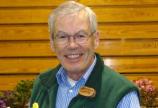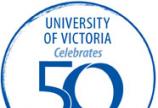The birth of UVic’s modern emergency response plan
- Brittany Schina

Dean Goard unzips a brown leather case and sifts through a well-organized collection of media releases and stories, each of which documents an event that shaped his 18 years as an employee of the University of Victoria. He is a planner by nature, and his careful planning shaped UVic’s emergency response strategies.
Goard speaks slowly, clearly and informatively. When the 2001 Olympia earthquake shook Vancouver Island, he remembers his reaction. “The blinds in my office were swinging back and forth, and I yelled ‘Hey, it’s an earthquake!’ and then I heard the secretaries in the office next to me screaming and I thought ‘maybe I shouldn’t be cheering’.” Although this earthquake happened before he took on the task of improving UVic’s emergency response system, Goard was prepared for and excited by such an event.
Goard arrived at UVic in 1987 as the secretary to the University President’s Council, created by the presidents of BC’s universities to provide a forum to address issues of system-wide interest. Because he was the sole employee on the council and lived in Victoria, it made sense for UVic—the university in the capital city—to house him and put him on its payroll, so he was employed in this position on campus from 1987 to 2001. His final position at UVic as special advisor to V-P Finance and Operations enabled him to focus on operations and planning and to assume the task of upgrading the emergency response efforts at the university.
Goard’s previous background in the public sector, combined with his natural ability to plan and organize, enabled him to negotiate and mediate between different interest groups to plan for disasters on campus.
Goard recalls sitting in his office on a late August day in 2002 and receiving a call from a colleague saying there was a gas leak and that campus was being evacuated. He realized this was unprecedented during his time at UVic. He called Campus Security where someone informed him that there was, in fact, a gas leak and directed him to go to the Ian Stewart complex. Goard passed the message along to Jack Falk, V-P finance, and to David Turpin, president of UVic, who packed up and walked to the Ian Stewart complex only to find no one there. Communications efforts to evacuate the campus had mostly failed.
“Needless to say, we now had the president’s and the senior executive’s attention that the system we had in place didn’t work,” Goard says.
“I was the planner, I didn’t have to do anything in emergency response, I just had to plan it,” Goard notes as he explains the 2002 campus evacuation. He recalls Oak Bay and Saanich police rushing to campus, people in buildings wondering why everyone was outside, people outside wondering why there are still people in buildings. “Total chaos,” he says.
Afterwards, a debriefing session was arranged during which Goard and his colleagues decided to adapt their emergency response to the BCERMS system (British Columbia Emergency Response Management System) used by the police, fire department and provincial government. “Without the chaos and screw-up of the first [evacuation], we wouldn’t have gotten the initiative to move forward,” Goard says.
Following the 2002 debriefing and campus evacuation, Goard and his team began doing training sessions with staff. The group did many exercises ranging from what to do if an oil spill happens to what to do in the event of a campus shooting. The unfortunate reality is, however, that not all emergencies can be planned for.
During their research, Goard and fellow-planners found that more students have died at Canadian universities from campus shootings than from fires. In order to plan for the possibility of a shooting, Goard talked to police who explained that there is really no formal training for what to do in the event of a shooting.
This planning and research brought to Goard’s attention that the most difficult thing to plan for in a major event is what to do with the students who call campus their home. “The students living in residence, what do you do about them? The rest, send them home, take a semester break until we get organized.”
In November of 2003, the Cunningham Building fire gave Goard the opportunity to see his response plans in action. At about six in the morning, Goard received a call, “Dean,” he imitates the voice on the end of the phone, “We’ve got a fire, do you want to come out and see how your plan is working?”
Following the BCERMS system, UVic personnel began to put on their vests with colours signifying their role in response to the fire. The Saanich Fire Department arrived on scene shortly after Campus Security and discovered that the fire had started in a laboratory on the third floor in the Cunningham Building. Much later it was discovered that the source of the fire was a light being used to facilitate plant growth. The cause was relatively minor but damage was done to the lab, smoke was in the building, and because of the necessary response to spray water in through a window on the third floor, each floor below was damaged. Now the recovery plans had to be put into action. What to do with the students and faculty who use this building? Not only were the labs unusable but also the smoke and presence of chemicals made the entire building unsafe.
“Luckily it was reading break and we had a break in time where we didn’t have students, so we had to start thinking, ‘Well, we can’t use those labs and we can’t use the building,’” Goard recalls. He explains the work that the response team did to recover the building and shuffle the classes that used it, explaining that the consensus was that the response to this emergency far succeeded any response that had taken place in the past.
The projects that Goard implemented that he feels left the most lasting impression on UVic are the business continuity plan and risk management. While he was on campus he felt he worked on the system as a whole, but these programs are two focused initiatives that are implemented and monitored by staff hired specifically for positions relating to these topics at UVic today.
Like all who left their footprint in UVic’s history, Goard has hopes and concerns about UVic’s future. “I would say there’s a disconnect between what universities do and what people think they do,” Goard explains, “What concerns me is that much of the growth in the past few years is research focused.” Goard feels that UVic, along with other universities in BC, needs to sharpen its mandate and focus.
“The mandates in BC post-secondary education aren’t clear any more,” Goard says. He is a strong believer in the university experience, opposing claims about the value of online degrees and technology taking over the traditional learning process at universities. He believes university helps teach not only academic subjects, but also how to interact with other people and other life skills. “Is it just about training for jobs or for a more informed citizenry?”
Goard used events like the gas leak campus evacuation, the Cunningham Building fire and other events on campus to motivate change in how emergencies are planned for at UVic. Institutions had typically disregarded the need to plan and allot a significant amount of budget money for emergency planning because it’s difficult to invest scarce dollars to a “what if” cause.
Goard’s legacy helped build UVic’s extensive emergency management program, which now includes over 500 trained staff, faculty and students involved in emergency response teams.


